Analysis: Russia to begin construction of two universal landing ships shortly - part 3
Zaliv Shipyard in Kerch will lay two new warships shortly. The universal landing ships (UDK) of project 23900 have to join the Navy by the end of 2027 and are the most expected ships in the past fifty years of the Russian Navy. The Profile magazine writes about the development of Russian amphibious assault forces.
Follow Navy Recognition on Google News at this link
 Priboy LHD scale model showcased by Krylov during Army 2016 exhibition. (Picture source: Navy Recognition)
Priboy LHD scale model showcased by Krylov during Army 2016 exhibition. (Picture source: Navy Recognition)
The Mistral deal had to provide modern marine carriers for over-horizon landing with air support at a major distance from deployment bases. It had to provide modern command warships and electronic equipment, including combat controls, as well as technological know-how in military and commercial shipbuilding for the upgrade of the domestic industry.
The 2014 conflict in Ukraine killed the deal and Mistrals were sold to Egypt. However, two of the four mentioned targets were achieved. The information obtained during Mistral construction was used in the Russian design of new warships. The Syrian campaign confirmed the significance of expeditionary forces in the navy. They will ensure more freedom of actions.
The available amphibious assault ships built in 1960-1980s were used for military transportation to Syria. Two big amphibious assault ships of project 11711 and LST concept of World War Two were built to replace them. However, as project 11711 did not meet modern realities of expeditionary forces, the construction pace was slow. The upgraded project 11711M partially eliminated the drawbacks. The ships got a helipad and an airpower of six helicopters. Two warships of the project have been built by Yantar Shipyard in Kaliningrad since 2019, however the task to create a universal landing ship remains.
The information about new amphibious assault ships boiled down to rumors and speculations for a long time. The Krylov Research Center added oil to fire, as its Priboi and Lavina models of landing ships have been demonstrated at various shows since 2015.
 Drawing of Project 23900 amphibious landing ship for the Russian Navy. (Picture source: Twitter)
Drawing of Project 23900 amphibious landing ship for the Russian Navy. (Picture source: Twitter)
The tactical and technical characteristics of new amphibious assault ships clarified in the spring of 2019 and were specified in January when a poster of the new warship was demonstrated to President Vladimir Putin at a meeting in Sevastopol. It was reported in the spring of 2020 that the new project received 23900 code. The prospective landing ship resembles Mistral with several changes. It is longer and has a bigger displacement. The flight deck has been increased and redesigned. It now allows simultaneously engaging the first wave of aircraft and preparing the second wave. The superstructure increased due to the second funnel which confirms a considerable change of the power plant parameters. It is difficult to guess, but the claim that the warship got a combined diesel and gas turbine power plant of project 22350 frigates remains vital. The propulsion is a step back against Mistral, as the Russian ship has a classical propeller-rudder shaft instead of propeller-rudder column on the French ship. It confirms problems with the production of domestic propeller-rudder columns, but is not a critical drawback.
In contrast to Mistral, there is no elevator for a heavy helicopter. Both posters showed to Putin displayed an option for medium helicopters. It is only logical as Russia is not designing heavy seaborne helicopters. If they appear, the ship can be easily upgraded. All the details will be known shortly when the ships are laid in Kerch. There are few questions, as despite a big size the amphibious assault ships are simple vessels without sophisticated arms carried by destroyers and frigates.
There are questions to frigates and corvettes which are to be in sufficient number to escort amphibious assault ships. There are questions to helicopters, as there is no news about the prospective Minoga seaborne rotorcraft. If the new warships join the Navy by the end of 2027, the helicopter for them has to take off in the coming month to have time for all trials and batch production preparation, the Profile weekly said.
© Copyright 2020 TASS Navy Recognition. All rights reserved. This material may not be published, broadcast, rewritten or redistributed.


























